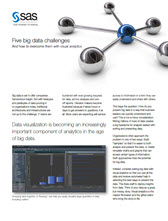
Big data is set to offer companies tremendous insight. But with terabytes and petabytes of data pouring in to organizations today, traditional architectures and infrastructures are not up to the challenge. IT teams are burdened with ever-growing requests for data, ad hoc analyses and one-off reports. Decision makers become frustrated because it takes hours or days to get answers to questions, if at all. More users are expecting self-service. Data visualization is becoming an increasingly important component of analytics in the age of big data. access to information in a form they can easily understand and share with others. This begs the question: How do you present big data in a way that business leaders can quickly understand and use? This is not a minor consideration. Mining millions of rows of data creates a big headache for analysts tasked with sorting and presenting data. Organizations often approach the problem in one of two ways: Build “samples” so that it is easier to both analyze and present the data, or create template charts and graphs that can accept certain types of information. Both approaches miss the potential
for big data. Instead, consider pairing big data with visual analytics so that you use all the data and receive automated help in selecting the best ways to present the data. This frees staff to deploy insights from data. Think of your data as a great, but messy, story. Visual analytics is the master filmmaker and the gifted editor who bring the story to life.
All information that you supply is protected by our privacy policy. By submitting your information you agree to our Terms of Use.
* All fields required.




